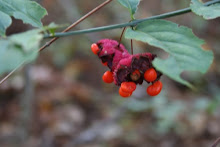This is a question I'm often asked. The answer is that I generally press with one of three different methods.
1.
 The method I most frequently use involves a homemade press made of peg board, air conditioning filters and paper. The peg board pieces make up the top and the bottom of the press. In between them you layer the remaining items as follows: air conditioning filter, blotting paper, flowers, blotting paper, air conditioning filter and so on. An advantage of this method over some others is that the air conditioning filters allow the flowers to sink in so the entire flower becomes exposed to pressure and not just the thick center. A lot of presses include wingnuts and bolts on all corners to give the flowers pressure. Instead of tightening nuts, I stack heavy boxes on my presses for the pressure.
The method I most frequently use involves a homemade press made of peg board, air conditioning filters and paper. The peg board pieces make up the top and the bottom of the press. In between them you layer the remaining items as follows: air conditioning filter, blotting paper, flowers, blotting paper, air conditioning filter and so on. An advantage of this method over some others is that the air conditioning filters allow the flowers to sink in so the entire flower becomes exposed to pressure and not just the thick center. A lot of presses include wingnuts and bolts on all corners to give the flowers pressure. Instead of tightening nuts, I stack heavy boxes on my presses for the pressure.2.
 Another favorite method of mine is the Microfleur. With this press, you sandwich your flowers, pop them into the microwave for several short spurts, and you have pressed flowers within minutes. You probably wouldn't use this method if you had hundreds of leaves to press because it would get pretty tedious and time consuming to be constantly taking leaves in and out of the microwave. Also, you have to let the microwave cool every now and then or else you'll catch it on fire...Sorry Mom and Dad! The advantage is you have what you need when you need it. If I'm working on a picture that just needs one special flower it's nicer to press it and have it immediately than to have to keep my picture on hold for five days while the plant material is pressing the other way. Another good thing about the Microfleur is that it allows you to press wet fleshy things such as mushrooms. Since it presses things so fast, the mushrooms or whatever don't have time to get moldy or yucky in their press.
Another favorite method of mine is the Microfleur. With this press, you sandwich your flowers, pop them into the microwave for several short spurts, and you have pressed flowers within minutes. You probably wouldn't use this method if you had hundreds of leaves to press because it would get pretty tedious and time consuming to be constantly taking leaves in and out of the microwave. Also, you have to let the microwave cool every now and then or else you'll catch it on fire...Sorry Mom and Dad! The advantage is you have what you need when you need it. If I'm working on a picture that just needs one special flower it's nicer to press it and have it immediately than to have to keep my picture on hold for five days while the plant material is pressing the other way. Another good thing about the Microfleur is that it allows you to press wet fleshy things such as mushrooms. Since it presses things so fast, the mushrooms or whatever don't have time to get moldy or yucky in their press.3.
 The other way I occasionally press and which I would recommend to a beginner is to use a phone book. The phone book was my first press. You can use it to find out if you like pressing flowers before you invest money in presses. You simply open the book, put in a piece of blotting paper, the flowers and another piece of blotting paper, then turn a chunk of pages and keep layering throughout the book. Weight on top of this is a good idea.
The other way I occasionally press and which I would recommend to a beginner is to use a phone book. The phone book was my first press. You can use it to find out if you like pressing flowers before you invest money in presses. You simply open the book, put in a piece of blotting paper, the flowers and another piece of blotting paper, then turn a chunk of pages and keep layering throughout the book. Weight on top of this is a good idea.Basic Pressing Guidelines:
1. Most pressing methods that I'm aware of have you put your plant material between a couple of pieces of blotting paper. I'm not sure if my definition is correct but I think of good blotting paper as any paper that doesn't have newsprint on it. If you use paper towel, make sure it doesn't have texture, unless you want little clouds embossed on your rose petals. Computer paper works well.
2. Contrary to those who say you should press flowers for a couple of months, what I've heard as a general rule is to let your flowers press for about five days. The flowers will feel different when they're done. They will not be as flimsy, they should feel paper-like and not wet.
3. Over the course of the pressing time it may be good to change your blotting paper a couple of times if it feels wet.
There are many, many other methods of pressing, but so far theses have worked well for me.


1 comment:
great article!:-)
thanks, sarah!:-)
rebekah:-)
Post a Comment